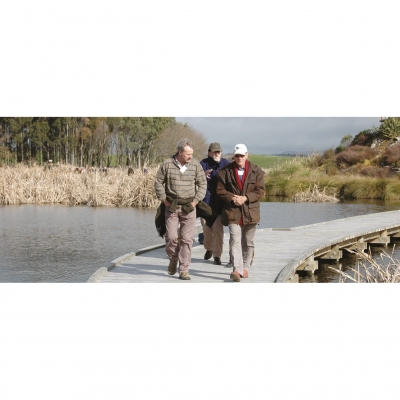Pekapeka Swamp – an icon for Hawke’s Bay
 Swamp transformation: Discussing the merits of the restoration, from left Will Abel, Chris Thomas and Jim Law.
Swamp transformation: Discussing the merits of the restoration, from left Will Abel, Chris Thomas and Jim Law.
Our intrepid group of AGM attendees visited the Pekapeka Swamp, squeezed in between the railway on the Eastern side, and State Highway 2 on the West. This area is well known to travellers who use SH2 south of Hastings. Older people who passed this way remember the swamp as being totally overgrown by grey willow. Steve Cave, Operations Environmental Manager for the Hawke’s Bay Regional Council (HBRC) explained the 98ha site is being restored to protect the cultural and historical value but also to help people understand the significance and important part wetlands play.
When Maori arrived in the area about 1530 this peat swamp, part of the limestone area, would have been very different. Its trip down hill started in 1873 with the dumping of rubble, fill and waste. The rail line was built in 1875. Between 1942 and 1970 channels were dug to drain the swamp, and in 1955 SH2 was straightened, cutting through the western side.
In 1970 Pekapeka was made a reserve. Willow control started in 1984 and finally a management plan to restore the wetland was approved by the HBRC. Helicopter and ground spraying targeted the willows. Community and school groups have put in many volunteer hours at the swamp. A clearing programme improved the flow of water through the wetland, and controlled animal and plant pests.
A plain to restore the wetland was approved by the HBRC in 1998. Work included a weir with a fish passage, to manage wetland flow, and funding allowed the site to be developed as a public reserve. Illegal dumping had continued at Pekapeka for many years and as a reminder of how wetlands had been treated it was decided to leave some rubble and reinforcing rods exposed as a reminder of the past.
Pekapeka opened to the public in 2010. Board walks, observation decks and even hides provide access and viewing points. Information boards give background and there is a picnic area. No toilets though. During duck shooting members of a local club use half the area and it is closed to the public. Club members are also involved in a predator control programme.
Steve said red tape, and resource consents often hold up restoration. So far it has cost them $60,000 for consents, eating into the small amount of funding they do receive. Thank goodness for volunteers.
Image Gallery
https://ducks.org.nz/flight-magazine/item/327-pekapeka-swamp-an-icon-for-hawke-s-bay#sigProIdadf1d94cac

